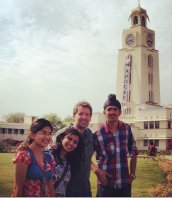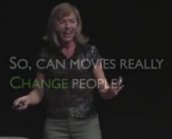Johanna Blakley
Media | Entertainment | FashionArchive for film
Story Money Impact: Funding Media for Social Change

I’m proud to have been included in Tracey Friesen’s excellent book Story Money Impact, which provides practical advice to media makers and funders who hope to change the world with through documentary films, digital content and independent journalism.
Tracey interviewed me about my work on Food, Inc. for a chapter about achieving behavior change through documentary film. The book also offers insights from the people who brought you CITIZENFOUR, Virunga, The Corporation, and Age of Stupid. It includes advice about creating compelling content, setting goals for social impact, and finding financial support for media work.
Later this month, there will be a hands-on workshop on Cortes Island, in beautiful British Columbia, called Media That Matters: Story Money Impact, which builds upon the insights gathered in the book. Scholarships are still available so check it out quickly!
Los Angeles – The Actual & the Imaginary City
Los Angeles may be the most mediated city in the world: it is the backdrop of countless media representations. No wonder we have a hard time grasping it: which part is real and which part is fake? Is it a fool’s errand to try to separate the two?
We’ll discuss this and much more on Sunday, August 7 at 4pm at the WUHO Gallery in Hollywood, which is exhibiting an experimental moving image installation called Median. Created by Bill Ferehawk and David Hartwell, Median presents a Los Angeles of drive-by impressions. It distills the city into the canned personas that it projects to its passers-by and lends perspective on the everyday urban tics through which the city is read.
With Median as the backdrop, I’ll moderate a panel discussion with some keen observers of Los Angeles’s urban experience, including:
Bill Ferehawk and David Hartwell, creators of Median
Naomi Iwasaki, Program Director of the Los Angeles Mayor’s Office Great Streets Program
David Ulin, author of Sidewalking: Coming to Terms with Los Angeles
Andrew Wilcox, landscape architect and contributor to LAtitudes: An Angeleno’s Atlas
INFO:
Sunday, August 7, 2016
The Making of Median: 3pm (LA Forum members only)
From the Street: Median in Conversation: 4pm (free and open to the public)
LA Forum Events @ WUHO Gallery
6518 Hollywood Boulevard, Los Angeles, CA 90028
Median is on view through Thursday, August 25, 2016
Gallery Hours: Friday, Saturday, and Sunday, noon to 5 pm
Mad Max & the Aesthetics of the Hack
I’d never seen an earlier installment in the Mad Max franchise when I went to see Fury Road at Grauman’s Chinese IMAX Theatre. I felt it was a movie I needed to see because so many people were asking me whether it succeeded in its effort to be a feminist action flick. But what really captured my imagination – and inspired me to watch all three of the previous films – was its singular vision and its relentless originality.
I often judge the sci fi I read by its ability to avoid exposition – to simply immerse me a world that is completely unfamiliar. This is a standard feature of cyberpunk style, which Bruce Sterling recently summarized at a terrific conference I attended at USC called Cyberpunk: Past and Future (videos are available).
Turns out that Sterling’s description fits Mad Max to a T. Read the rest of this entry »
Deflating the Filter Bubble
I was asked recently to speak at a symposium on Media Choices at Drexel University. The event drew a fascinating array of scholars who were studying things like Internet addiction, online dating, and political polarization in media consumption.
When someone mentions “media choice” to me, I automatically start thinking about the algorithms that have been developed to help shape that choice.
I have followed avidly the growing use of recommendation systems that you see on sites like Amazon, Netflix, YouTube and Pandora. I saw these mechanisms as a significant move away from demographic marketing (which I find deeply flawed) to marketing based on customer taste.
I did have my reservations though. I was very moved by Eli Pariser’s TED talk about the danger of “filter bubbles,” which effectively insulate us from opinions and content that we don’t understand or like. His talk really resonated with me because of the deeply divided ideological and taste communities that I found in a major survey research project I conducted on the correlation between entertainment preferences and political ideology (spoiler: they are even more deeply connected than you might think.)
But, when I conducted further research about collaborative filtering systems, I made some rather counter-intuitive discoveries. YouTube, for instance, found that “suggesting the videos most closely related to the one a person is already watching actually drives them away.”
Of course YouTube’s goal is to get you to sit and watch YouTube like you watch TV: to lean back and watch a half hour to an hour of programming, rather than watching for two minutes, getting frustrated trying to find something else worth watching and then going elsewhere. So, in short, it’s in YouTube’s best interest to introduce some calculated serendipity into their recommendations. Read the rest of this entry »
Participant Media’s Impact Index
The New York Times devoted significant ink this week to The Participant Index (TPI), an effort by Participant Media to quantify and compare the relative social impact of films, TV shows and online video. The article also mentioned the Lear Center’s $4.2 million Media Impact Project: I’m the co-principal investigator on that project and we’ve been consulting with Participant on the development of TPI.
Here’s a little back story: Participant approached the Lear Center because of its academic expertise in measuring the impact of educational messages embedded in entertainment content. Our Hollywood, Health & Society program (for which I wrote the initial grant) has partnered with the CDC for the last 14 years to look at how health story lines in popular TV shows affect viewers’ knowledge, attitudes and behavior. The survey component of TPI includes a combination of questions that have become standard in entertainment education evaluation: the “transportation scale” identifies the type of emotional involvement that the entertainment content triggered and the outcome questions indicate what real-world actions a subject has taken after exposure to the content. TPI combines these two measures to create a score for each piece of video content in the study. Read the rest of this entry »
Measuring the Impact of Art
Last week I attended a high-caliber symposium co-sponsored by the National Endowment for the Arts (NEA) and the UK’s Cultural Value Project. They brought together a dizzying array of researchers (demographers, cognitive scientists, arts policy wonks, “recovering” academics, etc.) to discuss how we ought to measure participation in arts and culture on the local, regional, national and global scale.
“Participation” and “engagement” are key metrics for arts institutions and their funders. But the inquiry often ends right there. I think the vast majority of people in the arts – including artists and administrators – take it as a given that art has a beneficial effect on society. I happen to agree with them. Wholeheartedly. But many powerful people in this world – including those who hold the purse strings – are not necessarily convinced. Funding for the arts is paltry compared to expenditures on science, where, lo and behold, we have a lot of convincing evidence about the importance it holds for humanity. Read the rest of this entry »
11 Things You Didn’t Know About Documentary Film Lovers
I was honored to give the Industry Keynote at Hot Docs, a giant documentary film festival in Toronto. I don’t know what they put in that water (which was delicious, by the way) but Torontonians love, love LOVE documentaries. They have a 700 seat theater that, year round, shows docs only, and I was completely charmed by its tagline: ESCAPE TO REALITY.
Of all conventional TV and film genres, you could easily argue that documentary is the one that is most self-conscious about its artful manipulation of reality. Since much of my research focuses on the impact of entertainment and media on individuals, communities and society at large, documentaries have proven an especially exciting object of study. (I have a TEDx talk about some of this research.)
In order to prep myself for the fest – which included a whopping 197 documentaries – I thought I’d revisit some survey research that we conducted at the Lear Center on the relationship between political beliefs and entertainment preferences. We discovered in those studies that predictable patterns emerged suggesting that even our escapes from reality – to ballets, tractor pulls, and blockbuster films – were tethered quite tightly to our deeply held beliefs about the world and how it ought to be.
For a nerd like me, this is absolutely fascinating stuff.
Our archive of data – from two large American representative sample surveys, and from a smaller version we conducted in Tunisia after the Arab Spring – includes detailed demographic, ideological and taste information about documentary film fans. Hot Docs gave me an excellent excuse to mine that data. Read the rest of this entry »




















